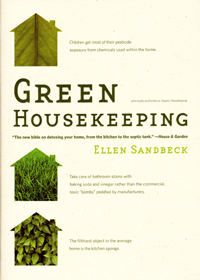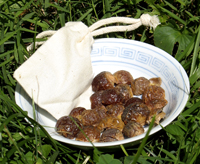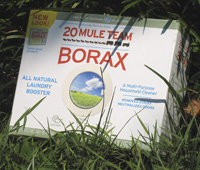There′s a lot of ″green″ advice in books, in magazines, and online. Too much of it describes what we should do, or what might be good to do, or what somebody plans to do. We all know what happens when theory gets practical: the bugs jump out.
 Green Housekeeping by Ellen Sandbeck is a different animal altogether. Too quirky to be anything but real, the book describes her actual experience and why her practice is effective.
Green Housekeeping by Ellen Sandbeck is a different animal altogether. Too quirky to be anything but real, the book describes her actual experience and why her practice is effective.
I′ll follow my ″three cool things″ format of recommendation, starting with the method that won my own housekeeping-averse heart.
Cleaning Simplicity
There are two magic ingredients: vinegar and hydrogen peroxide. Both are safe, natural substances produced by living organisms. (Our own bodies actually create hydrogen peroxide – H2O2 – as a byproduct of our metabolism.)
When hydrogen peroxide encounters organic material (think germs) it releases its extra oxygen atom, becoming mere water (H2O) in the process. That′s what all that foaming and bubbling is when you spray: the extra oxygen is popping off and killing bacteria.
Vinegar kills a lot of bacteria on its own, but hydrogen peroxide kills 100 times as many. When you give a squirt of both, you get another tenfold increase.
Let′s look at some numbers. Say a splash of vinegar from your spray bottle kills 1000 bacteria. A misting of hydrogen peroxide alone would zap 100,000 bacteria. While a spray of both gets 1 million. But all that′s left after spraying is harmless water. No chemical residue. I like it!
 All you need is a spray bottle of vinegar and an original bottle of hydrogen peroxide with a sprayer cap screwed onto it. Put one pair in your kitchen and another in each bathroom. You′re set to keep those critical places safely clean.
All you need is a spray bottle of vinegar and an original bottle of hydrogen peroxide with a sprayer cap screwed onto it. Put one pair in your kitchen and another in each bathroom. You′re set to keep those critical places safely clean.
Why the original bottle? Hydrogen peroxide loses its extra oxygen very easily. Just decanting it into another container can make that happen, as can light shining through a translucent spray bottle. You want water as an end product after cleaning, not as a starter!
Once I placed my paired solutions on location, I found myself using them frequently. Not running to fetch them was just as magical as the solutions themselves. (Needing to fetch often leads to not fetching at all, for me.) Just: squirt! squirt! done! (Or add a quick swipe with the microfiber rag kept by the bottles, if adhering toothpaste or avocado needs a scrub.) Cleaner sinks!
Laundry Boost
 I use Berry+ and soap ″nuts″ to launder clothes and household linens. Soap ″nuts″ (or soapberries) are fruits of the tree sapindus mukorossi. The fruits can be used dried or to create a liquid extract (Berry+).
I use Berry+ and soap ″nuts″ to launder clothes and household linens. Soap ″nuts″ (or soapberries) are fruits of the tree sapindus mukorossi. The fruits can be used dried or to create a liquid extract (Berry+).
Why don′t I choose one or the other?
Convenience.
We do a lot of cold water laundry loads. I love being able to pop open a capsule of Berry+, pour it into the washer, close the lid, start the cycle, and go.
 Soap nuts must either be soaked for 5 minutes in warm water (then dumped along with the soak water into the washer) or tossed into a washer destined for a warm or hot water wash. Since my husband and I are both allergic to dust mites, our sheets, pillowcases, blankets, and towels must be laundered in water over 130°F. (The high temp gets rid of the allergens.) Soap nuts are perfect for that job.
Soap nuts must either be soaked for 5 minutes in warm water (then dumped along with the soak water into the washer) or tossed into a washer destined for a warm or hot water wash. Since my husband and I are both allergic to dust mites, our sheets, pillowcases, blankets, and towels must be laundered in water over 130°F. (The high temp gets rid of the allergens.) Soap nuts are perfect for that job.
The advantage of both soap nuts and Berry+ is that the outflow spilling from my washer to the water treatment plant is non-toxic. Soapberries have been used by the peoples of Asia and by Native Americans for thousands of years. That′s time tested!
I fell in love with soapberries when I found that my berry-laundered clothes developed almost zero static cling in the dryer and emerged from it smelling faintly of freshly ironed cotton. Yum!
(Alas, yes, I do use a dryer. Although our drying rack is usually equally full once I′ve emptied the washer.)
But what to do when the grass stains or the clay stains or whatever need extra cleaning? Sometimes spot treatment with Berry+ will do the trick. Sometimes it won′t.
Ellen Sandbeck′s chapter on laundry educated me about an old-fashioned product that′s never truly left the cleaning lexicon and is now enjoying a resurgence of use: 20 Mule Team Borax, around since 1891.
 Borax is a naturally occurring mineral salt composed of boron, sodium, oxygen, and water. It functions as a water softener, fabric softener, deodorant, and mild bleach. I add 2 – 4 tablespoons of it to a load when I face especially challenging laundry. (Or apply a paste of it to the stubborn spot.)
Borax is a naturally occurring mineral salt composed of boron, sodium, oxygen, and water. It functions as a water softener, fabric softener, deodorant, and mild bleach. I add 2 – 4 tablespoons of it to a load when I face especially challenging laundry. (Or apply a paste of it to the stubborn spot.)
Is it perfect?
No.
But it′s helpful to have a stronger benign option in my tool kit.
The Well-Tempered Clavier
Sandbeck compares a happy home to J.S. Bach′s harpsichord after it has been tuned by the method he invented. No one key is perfectly in tune, but all are sufficiently so to sound good. Compromises must be made. (The method before Bach′s invention resulted in one key perfectly in tune and the rest decidedly out of tune.)
Sandbeck says: ″Most people are happiest and at ease in homes that are moderately clean and neat. Both extremes . . . tend to make people unhappy and uncomfortable.″ Also: ″The well-tempered house should be just neat and clean enough to make both the neatest person and the sloppiest person in the household just a tiny bit dissatisfied.″
Sounds fair to me!
Those are my three favorite snippets from Green Housekeeping, but the book′s packed with tips. Your favorites will likely be different than mine, since homes vary as much as their inhabitants. I invite you to find yours!
For more on green living, see:
Grass Green
Great Soap & Etcetera Quest
Wrapping with Cloth
